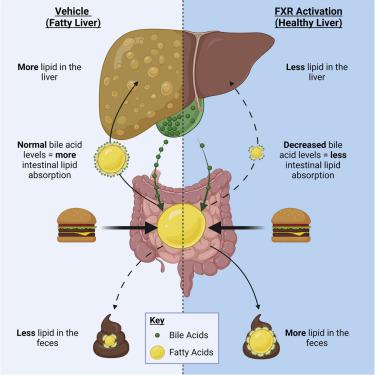Cell Metabolism ( IF 27.7 ) Pub Date : 2021-07-15 , DOI: 10.1016/j.cmet.2021.06.012
Bethan L Clifford 1 , Leslie R Sedgeman 1 , Kevin J Williams 2 , Pauline Morand 3 , Angela Cheng 3 , Kelsey E Jarrett 1 , Alvin P Chan 1 , Madelaine C Brearley-Sholto 1 , Annika Wahlström 4 , Julianne W Ashby 1 , William Barshop 3 , James Wohlschlegel 3 , Anna C Calkin 5 , Yingying Liu 6 , Anders Thorell 7 , Peter J Meikle 8 , Brian G Drew 9 , Julia J Mack 10 , Hanns-Ulrich Marschall 4 , Elizabeth J Tarling 11 , Peter A Edwards 12 , Thomas Q de Aguiar Vallim 13

|
FXR agonists are used to treat non-alcoholic fatty liver disease (NAFLD), in part because they reduce hepatic lipids. Here, we show that FXR activation with the FXR agonist GSK2324 controls hepatic lipids via reduced absorption and selective decreases in fatty acid synthesis. Using comprehensive lipidomic analyses, we show that FXR activation in mice or humans specifically reduces hepatic levels of mono- and polyunsaturated fatty acids (MUFA and PUFA). Decreases in MUFA are due to FXR-dependent repression of Scd1, Dgat2, and Lpin1 expression, which is independent of SHP and SREBP1c. FXR-dependent decreases in PUFAs are mediated by decreases in lipid absorption. Replenishing bile acids in the diet prevented decreased lipid absorption in GSK2324-treated mice, suggesting that FXR reduces absorption via decreased bile acids. We used tissue-specific FXR KO mice to show that hepatic FXR controls lipogenic genes, whereas intestinal FXR controls lipid absorption. Together, our studies establish two distinct pathways by which FXR regulates hepatic lipids.
中文翻译:

FXR 激活通过依赖胆汁酸减少脂质吸收来预防 NAFLD
FXR 激动剂用于治疗非酒精性脂肪性肝病 (NAFLD),部分原因是它们可降低肝脂质。在这里,我们表明使用 FXR 激动剂 GSK2324 激活 FXR 通过减少吸收和选择性减少脂肪酸合成来控制肝脂质。使用全面的脂质组学分析,我们表明 FXR 在小鼠或人类中的激活会特异性降低肝脏中单不饱和脂肪酸和多不饱和脂肪酸(MUFA 和 PUFA)的水平。MUFA 的减少是由于 FXR 依赖性抑制Scd1、Dgat2和Lpin1表达,它独立于 SHP 和 SREBP1c。PUFA 的 FXR 依赖性减少是由脂质吸收的减少介导的。在饮食中补充胆汁酸可防止 GSK2324 治疗小鼠的脂质吸收减少,这表明 FXR 通过减少胆汁酸减少吸收。我们使用组织特异性 FXR KO 小鼠来证明肝脏 FXR 控制脂肪生成基因,而肠道 FXR 控制脂质吸收。总之,我们的研究建立了两种不同的 FXR 调节肝脂质的途径。































 京公网安备 11010802027423号
京公网安备 11010802027423号